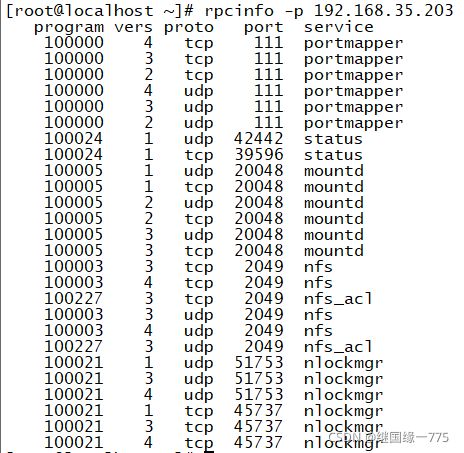centos 7安装Haproxy+nginx+nfs
文件目录
环境
实验步骤:
一.两台Nginx服务器配置
二.HAProxy负载均衡策略
三.nfs搭建
四.验证
环境
- 四台虚拟服务器模拟搭建一套Web集群;网站使用nginx搭建;
主机 IP地址 主要软件 Haproxy 192.168.35.181 haproxy Nginx 192.168.35.201 nginx-1.8.1.tar.gz Nginx 192.168.35.202 nginx-1.8.1.tar.gz Nfs 192.168.35.203 rpc-bind nfs-utils 实验步骤:
关闭防火墙
systemctl disable firewalld.service systemctl stop firewalld.service一. 安装nginx两台
依赖包安装
yum -y install gcc gcc-c++ autoconf automake libtool make openssl openssl-devel pcre pcre-devel切换安装路径
cd /usr/local/src/下载nginx,如果提示没有wget请自行安装yum -y install wget
wget http://nginx.org/download/nginx-1.8.1.tar.gz解压安装包
tar -zxvf nginx-1.8.1.tar.gz打开压缩出来的目录
cd nginx-1.8.1编译命令
./configure \ --prefix=/usr/local/nginx \--with-http_ssl_module \ --with-http_flv_module \ --with-http_stub_status_module \ --with-http_gzip_static_module \ --with-pcre安装
make && make install常用命令
# 进入生成目录 cd /usr/local/nginx # 测试 /usr/local/nginx/sbin/nginx -t # 查看编译模块信息 /usr/local/nginx/sbin/nginx -V # 启动 /usr/local/nginx/sbin/nginx # 重新载入配置文件 /usr/local/nginx/sbin/nginx -s reload # 重启 /usr/local/nginx/sbin/nginx -s reopen # 停止 /usr/local/nginx/sbin/nginx -s stop测试nginx1和nginx2
二. 编译安装
yum -y install pcre-devel bzip2-devel百度网盘提取haproxy包
百度网盘 提取码g8n3
rz上传
tar zxf haproxy-1.5.19.tar.gz -C /usr/src/ cd /usr/src/haproxy-1.5.19/ make TARGET=linux26 && make install建立haproxy配置文件
[root@localhost ~]# mkdir /etc/haproxy //创建配置文件目录 [root@localhost ~]# cd /usr/src/haproxy-1.5.19/ [root@localhost haproxy-1.5.19]# cp examples/haproxy.cfg /etc/haproxy/根据目前的群集设计,将haproxy.cfg配置文件内容修改如下
global log /dev/log local0 info log /dev/log local0 notice #log loghost local0 info maxconn 4096 #chroot /usr/share/haproxy uid 99 gid 99 daemon #debug #quiet defaults log global mode http option httplog option dontlognull retries 3 redispatch maxconn 2000 contimeout 5000 clitimeout 50000 srvtimeout 50000 listen webserver 0.0.0.0:80 option httpchk GET /index.html balance roundrobin server inst1 192.168.35.201:80 check inter 2000 fall 3 server inst2 192.168.35.202:80 check inter 2000 fall 3创建自启动脚本
[root@localhost ~]# cd /usr/src/haproxy-1.5.19/ [root@localhost haproxy-1.5.19]# cp examples/haproxy.init /etc/init.d/haproxy [root@localhost haproxy-1.5.19]# ln -s /usr/local/sbin/haproxy /usr/sbin/haproxy [root@localhost haproxy-1.5.19]# chmod +x /etc/init.d/haproxy [root@localhost haproxy-1.5.19]# chkconfig --add /etc/init.d/haproxy [root@localhost haproxy-1.5.19]# /etc/init.d/haproxy start Starting haproxy (via systemctl): [ 确定 ] [root@localhost ~]# systemctl stop firewalld测试haproxy
开启haproxy监控页面
编辑haproxy.cfg 加上下面参数
listen admin_stats stats enable bind *:8080 mode http option httplog log global maxconn 10 stats refresh 30s stats uri /admin stats realm haproxy stats auth admin:admin stats hide-version stats admin if TRUE保存退出后
重起service haproxy restart
然后访问 http://ip:8080/admin 用户名:admin码:admin
三. 搭建NFS服务器
1. 因为centos7自带了rpcbind,所以不用安装rpc服务,rpc监听在111端口,可以使用
yum -y install nfs-utils #安装nsf查看rcp是否启动
ss -tnulp | grep 111如果没有启动就用一下代码启动
systemctl start rpcbind 启动rcp2. 使用 rpm -qa nfs-utils 查看是否安装成功
3. 编辑/etc/exports ,添加以下内容
/data 192.168.35.0/24(rw,async)
4. 启动nfs服务,systemctl start nfs ,启动后 使用rpcinfo -p 192.168.35.203 查看,如图所示
5. 使用showmount -e localhost
6. 创建/data目录添加文件,更改权限(很重要!!!!!)
mkdir /data
touch /data/1.txtecho "hello nfs" >> /data/1.txt
chown -R nfsnobody.nfsnobody /data
1. 在两台nginx执行
yum -y intall nfs-utils #安装nfs2. 查看rpc是否启动
ss -tnulp | grep 1113. 使用showmount -e 192.168.35.203查看
4. 挂载至本地/mnt目录
[root@localhost ~]# mount -t nfs 192.168.35.203:/data /mnt [root@localhost ~]# ls /mnt/ 1.txt [root@localhost ~]# echo "2222" >> /mut/1.txt5.接下来在服务器端执行
systemctl enable nfs-server.server
systemctl enable rpcbind
让nfs,rpcbind开机自动启动,实验完成。








